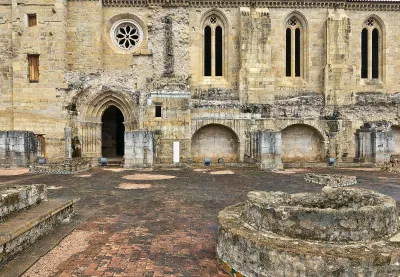
Convento de Santa Clara-a-Velha José Luis Filpo Cabana CC BY-SA
Monastery of Santa Clara-a-Velha Carlos p. gonçalves CC BY-SA
Santa Clara-a-Velha Carlos Luis M C da CruzFounded in 1314 by Queen Isabel (Elizabeth of Aragon), the Gothic Convento de Santa Clara was built close to the banks of the River Mondego, across from Coimbra. Isabel was the wife of king D. Dinis and it is said she was most generous and sympathetic towards the poor. In fact the story goes that the king had to reign in Queen Isabel's spending.
Upon the death of King Dinis, Isabel retired to the Santa Clara convent and joined the Order of St Francis, devoting herself to helping the poor and the sick. She died in 1336, 10 years after her husband, and was buried in the convent that she had given so much of her life to. Her body was laid to rest in a magnificent Gothic sarcophagus. Not long after her death she was canonised becoming Saint Isabel of Portugal.
Unfortunately, almost from the moment it was built the convent suffered from flooding. So severe and disruptive was this that the Santa Clara was finally abandoned in 1677 and a new convent (Santa Clara-a-Nova) was built on higher ground. The remains of the now Saint Isabel were moved to the new convent along with the original tomb. However, her remains were transferred to a silver and crystal urn which was placed behind the altar.
After the convent was moved the old building was left to the constant floodwaters and became half buried in silt. It was only 300 years later that the ruins were excavated and restored. The ruins of the main church are fairly well-preserved featuring stone vaulted ceilings and three rose windows. Much of the rest of the old convent has fared less well with the cloisters reduced to a collection of stump like pillars and only the foundations of Isabel's palace remaining.
Coimbra3040-266Attraction type

Coimbra travel guide »
In terms of historic significance and romantic beauty, Coimbra is second only to Lisbon and Oporto. Its ancient buildings cling to the side of the hill that rises above the curves of the river Mondego, the ornate buildings of the famous University of Coimbra are its crowning glory. Indeed the university is still the lifeblood of the city and the change in atmosphere is notable when the…